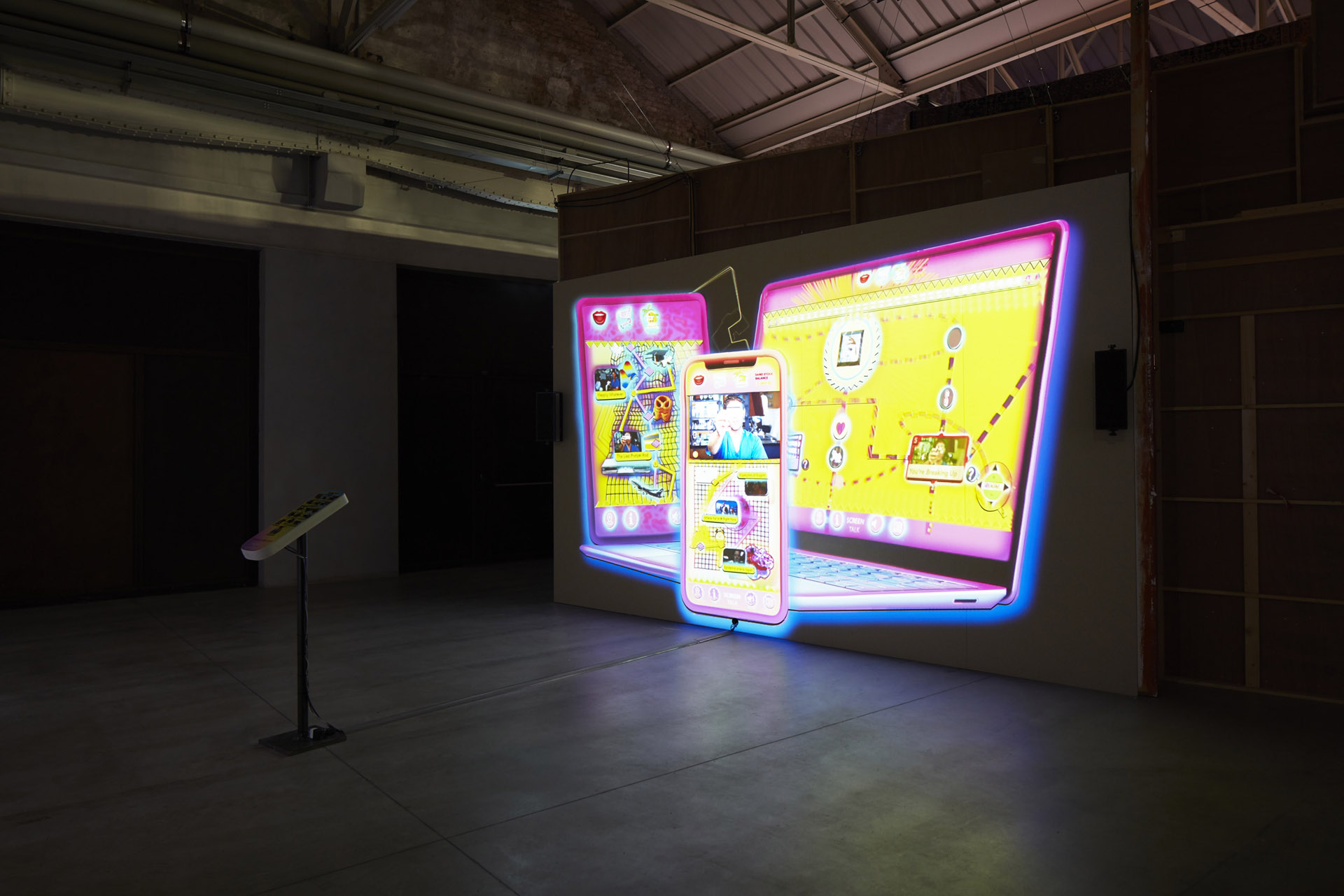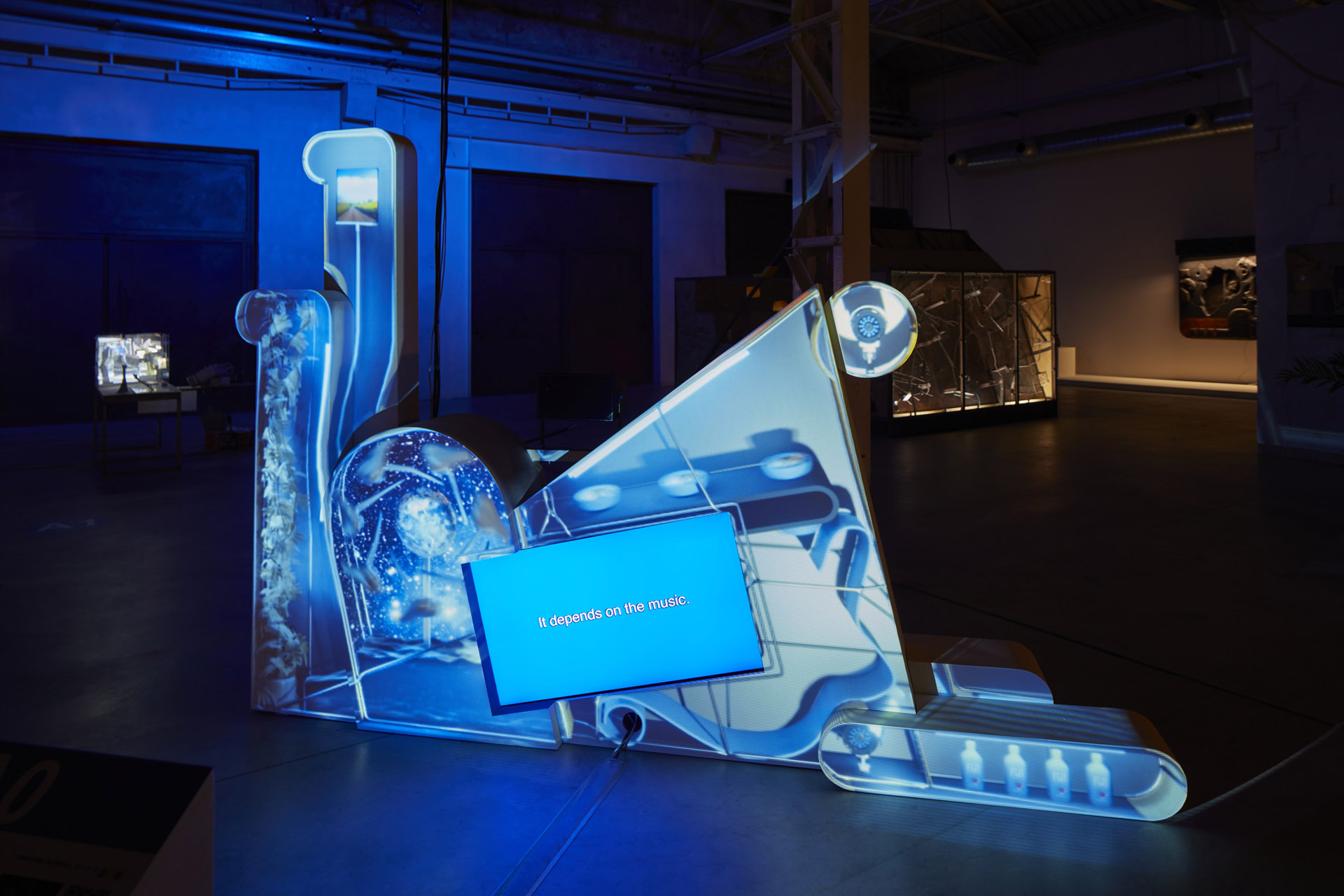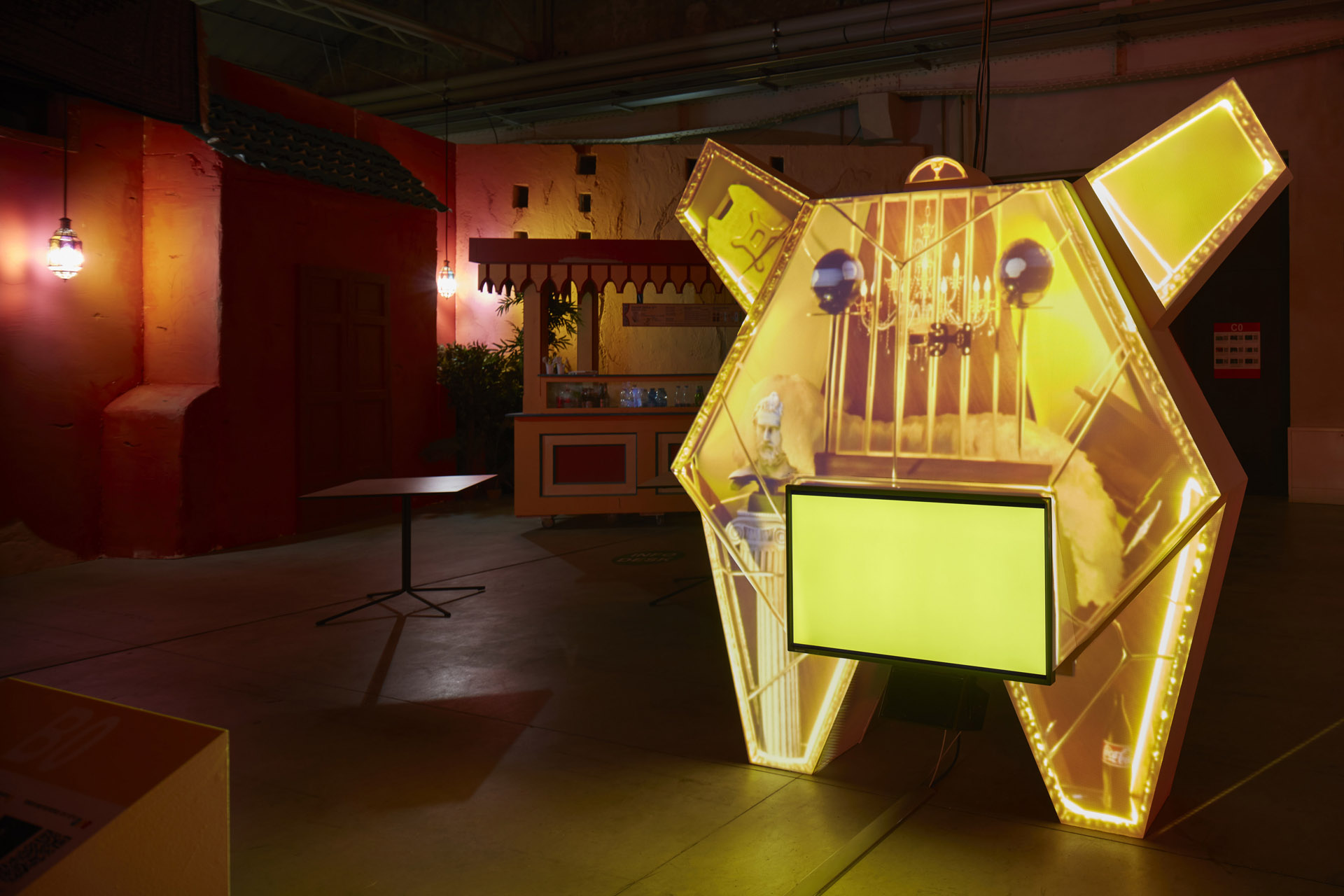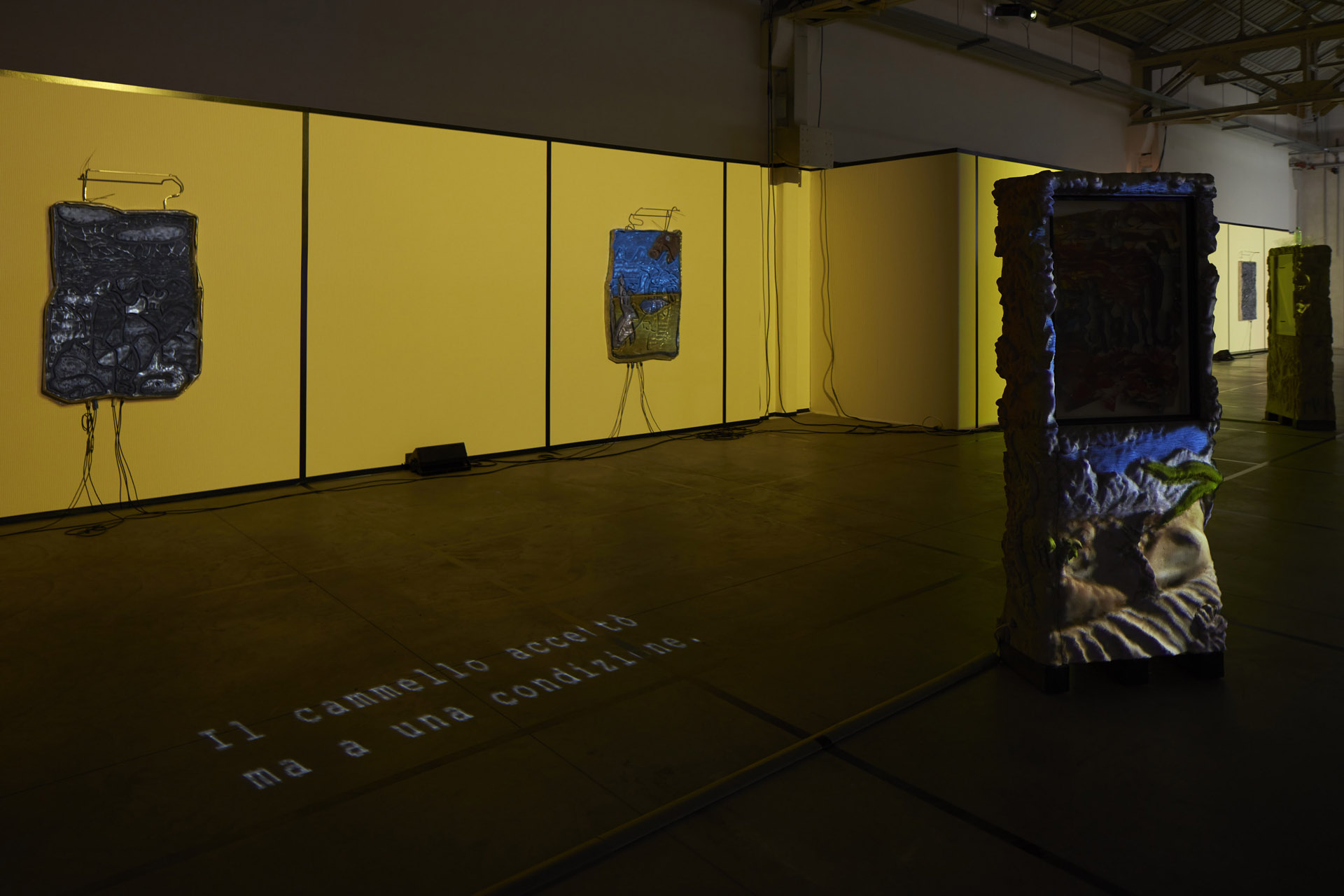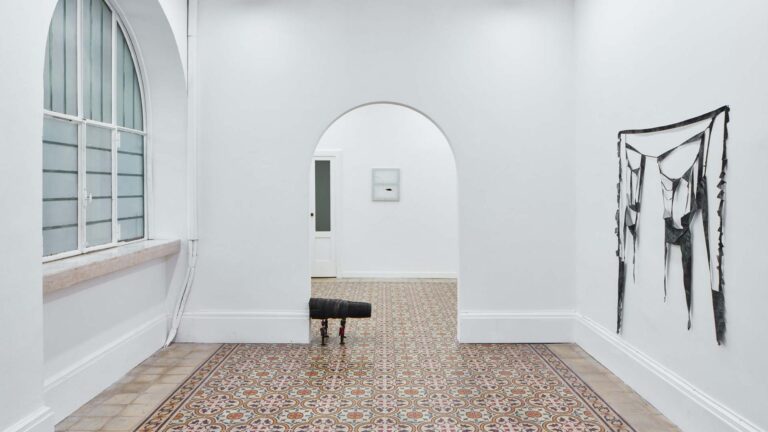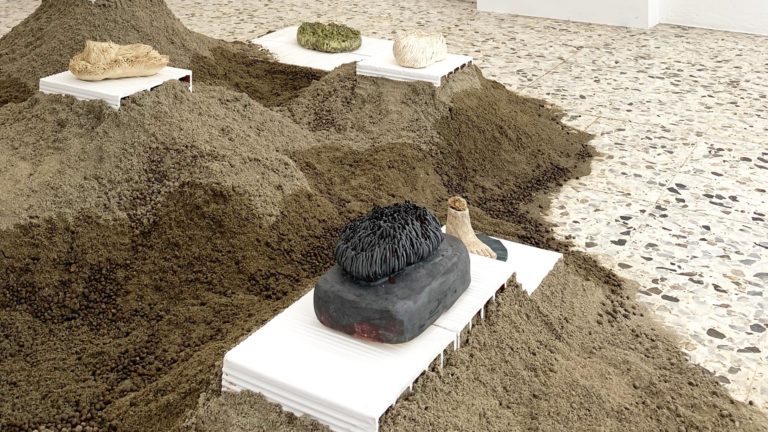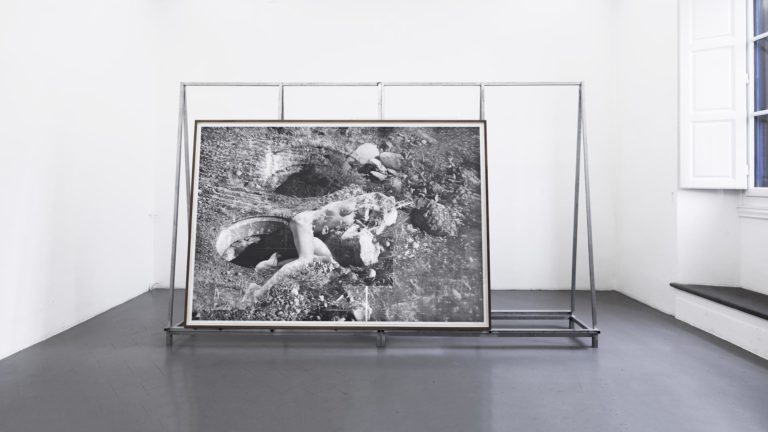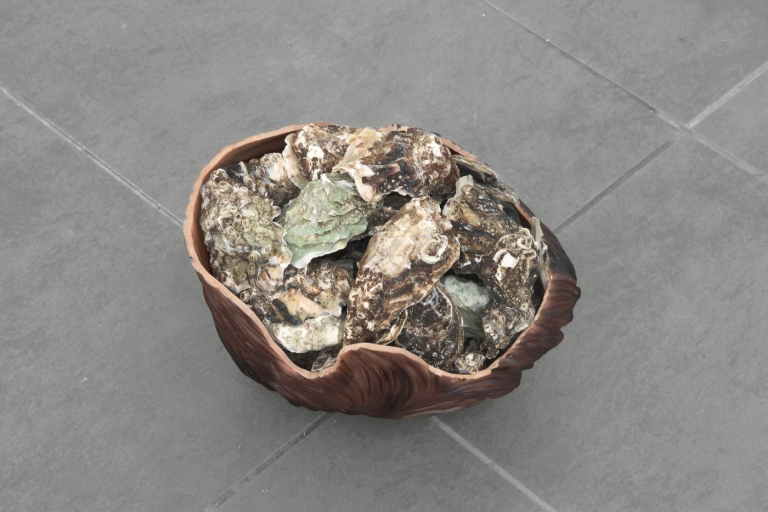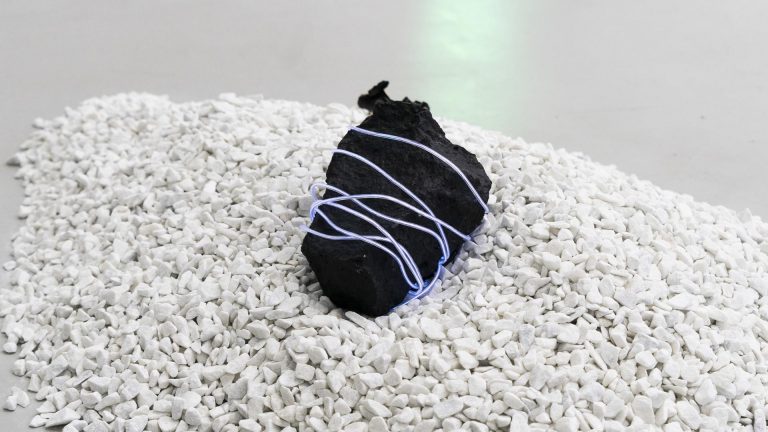Artist: Neïl Beloufa
Exhibition title: Digital Mourning
Curated by: Roberta Tenconi
Venue: Pirelli HangarBicocca, Milan, Italy
Date: February 16 – July 18, 2021
Photography: all images copyright and courtesy of the artist and Pirelli HangarBicocca
Note: Exhibition guide is available here
From 17 February to 18 July 2021, Pirelli HangarBicocca presents Neïl Beloufa’s solo exhibition. The French-Algerian artist is one of the leading voices of the past decade and a keen observer of our times, offering vivid representations of the world through films, videos, installations, and sculptures.
Avoiding direct judgements and forceful declarations, Beloufa successfully conveys a reality that, in its subtlety, is often awkward to behold, focusing on highly topical issues such as power relationships, the technological control, the perils of data collection, as well as on a possible collapse in the management of a pandemic.
Digital Mourning, curated by Roberta Tenconi, is the first major solo exhibition devoted to Neïl Beloufa in an Italian institution, and it stems from a reflection on the current times and on the concept of life in our digital world. Right from the title, the exhibition alludes to one of the most striking paradoxes of contemporary society, which is the existence in a technological world and its parallel disappearance. The association of the two words—“digital” and “mourning”—comes about in the encounter between an artificial world and the absence of life, in a dimension in which life itself is simulated by means of models specially created to understand its true essence.
Playing on a combination and intermingling of genres, Digital Mourning is a complex new multimedia installation conceived specifically for the space of the Shed at Pirelli HangarBicocca, presenting, at the same time, a retrospective of Neïl Beloufa’s video works. The exhibition consists of a wide selection of films and video works that retrace the artist’s career from his debut (with Kempinski, 2007) through to his most recent productions, few of which are projected inside multimedia installations originally designed for them by the artist. Together, these form part of a computerised activation and re-editing system that abolishes any hierarchy between the different types of information.
Resembling the scenario of an “amusement” park, the space embraces a large selection of works, including the artist’s most relevant installations and walk-through sculptures. However, mimicking the current state of affairs, it is forbidden to use the “attractions” and the exhibition appears to come alive only through a series of narrative voices. In presenting the works and explaining the viewers what to see in each area, the narrators introduce and discuss different positions, from utopian aspirations to the opinions of the youngest generation. While making a new total artwork out of former works, the exhibition is as well adapting the way we consume culture these days, for example by playing with the flux of information and the attention span standard viewers have or by providing links to watch films directly at home.
Right from his first work, Kempinski (2007), Neïl Beloufa has called conventions into question. Shot in Bamako, Mali, the video consists of a series of brief interviews in which the artist subtly breaks the stylistic rules of the genre. While maintaining the spirit of authenticity that is typical of documentaries, the dialogues between the participants describe a world totally devoid of any of the stereotypical ideas about the African continent. Instead, he creates fantastical, surreal scenarios simply by using the present tense to talk about a hypothetical future. This allegory of the contemporary world and its fragility can also be seen in the kinetic installation People’s Passion, transparency, mobility, all surrounded by water (2018), which includes the homonymous video. The work is based on a series of interviews by the artist with the inhabitants of a new residential complex in North America, revealing all the artificiality inherent in the perception of lifestyle and wellbeing of the Western world. Equally powerful is the idea of the highly rhetorical reality presented in World Domination (2015), in which Neïl Beloufa uses non-professional actors and role-playing to defend positions that are arbitrarily attributed. Projected onto the irregular surface of a motorised wall that moves on a track, the video shows five diplomatic tables and scenes where international issues such as obesity and financial investments are discussed, often ending in clear contradictions and calls for war. Lastly, the show presents a new expanded version of La morale de l’histoire (2019), made especially for this occasion. The immersive installation is conceived as a technological fairy-tale that tells the story of a camel and some fennecs who built a stone wall in the desert to shelter from the sun at the expense of a colony of ants. The work, which deliberately uses the narrative form of children’s stories to create a metaphor of the capitalist economy, closes the exhibition and truly acts as a conclusion or summary for all the other stories and works.
The various installations turn Digital Mourning into an immersive environment, in which the impulses created by the images, sounds and lights are synchronised in a complex sequence that guides the viewer’s movements. The switching on and off of one or more works at the same time creates a one of a kind choreography, in which some works come to life while others lie in frozen sleep. The rhythm of the narrative is set by the narrating voices, the so-called “Hosts”, in which the audio channels are programmed to give the viewer “orders.” This means that, as the artist puts it, the public is “in a free but uncomfortable position that should lead to thinking about what is shown instead of believing it”. In creating this control system, Neïl Beloufa brings into question permeable concepts such as truth and fiction and shows how they interweave in the contemporary world, explaining their mechanisms as clearly as if he was describing the devices and wiring at the heart of his works.
What’s more, in the spring Neïl Beloufa will present his exhibition The Moral of the Story in the city center. The project is promoted by Fondazione Henraux and will comprise four previously unseen installations by the artist, on display in the amphitheater of the Apple Store in Piazza Liberty. The works, produced by Henraux in marble, will be on show both during the day and into the evening.
Neïl Beloufa (b. 1985, Paris) is one the most powerful voices of the generation of artists born in the 1980s. His artistic research focuses on contemporary society and on how it is represented and mediated by digital interaction, often with the aim of exposing the control mechanisms that have become rooted in our daily lives. In his videos, feature films, sculptures, and technologically complex installations, Beloufa plays on the viewer’s sensory experience, inviting them to reappraise their own beliefs and stereotypes. He addresses present-day issues that range from power relationships to digital surveillance, to data collection and nationalistic ideologies, to identity and a post-colonial understanding of the world.
Neïl Beloufa’s work is strongly influenced by the world of the web, by videogames, by reality TV and political propaganda, using the vocabulary of the information age to lift the lid on the value system of a society permeated with digital technology, where everything, from food choices to human relationships is established on the basis of an algorithm. In this process, the artist refers to himself as an editor, an assembler, who puts together information that already exists only to break it down again and show us the outcome without making any moral judgment. His aim is to bring about a short-circuit within normal settings, to throw off track assumptions that are commonly accepted as true, and to restore the viewer’s freedom to create new relationships and personal meanings. The viewers thus find themselves inside immersive installations that convey a fragmented vision of reality, a universe inhabited by pop-ups and live CCTV networks that are designed to reveal both the freedom of an apparently random system and the degree of control that underpins it.
The great present-day relevance of Neïl Beloufa’s work is evident in his production process as much as in the scenarios he creates. His works are entirely realized in his studio, with the aim of creating an alternative model of economic sustainability based on a sharing of skills. This collective powerhouse creates works that closely reflect the contemporary world and, in some cases, even anticipate it, often addressing its most pressing and problematic issues. This is the case of Screen Talk (2020), an experimental project that transforms a video, Home Is Whenever I’m With You (2014), into a web series. In the video, the artist imagined a global pandemic and the race between competing medical laboratories to find a cure. This scenario, which he made up in 2014 as pure fiction, has taken on a completely new meaning today, being now enriched with references to how human relationships and communications have been transferred almost entirely into digital form.
Neïl Beloufa, Screen Talk, 2020–ongoing, Installation view, Pirelli HangarBicocca, Milan, 2021, Courtesy Bad Manner’s Paris/Miami/Ibiza, kamel mennour, Paris/London, François Ghebaly, Los Angeles, Mendes Wood DM, ZERO…, Milan and Pirelli HangarBicocca, Milan, Photo: Agostino Osio
Neïl Beloufa, Exhibition view, “Digital Mourning”, Pirelli HangarBicocca, Milan, 2021, Courtesy the artist and Pirelli HangarBicocca, Milan, Photo: Agostino Osio
Neïl Beloufa, Exhibition view, “Digital Mourning”, Pirelli HangarBicocca, Milan, 2021, Courtesy the artist and Pirelli HangarBicocca, Milan, Photo: Agostino Osio
Neïl Beloufa, Exhibition view, “Digital Mourning”, Pirelli HangarBicocca, Milan, 2021, Courtesy the artist and Pirelli HangarBicocca, Milan, Photo: Agostino Osio
Neïl Beloufa, Exhibition view, “Digital Mourning”, Pirelli HangarBicocca, Milan, 2021, Courtesy the artist and Pirelli HangarBicocca, Milan, Photo: Agostino Osio
Neïl Beloufa, Exhibition view, “Digital Mourning”, Pirelli HangarBicocca, Milan, 2021, Courtesy the artist and Pirelli HangarBicocca, Milan, Photo: Agostino Osio
Neïl Beloufa, Exhibition view, “Digital Mourning”, Pirelli HangarBicocca, Milan, 2021, Courtesy the artist and Pirelli HangarBicocca, Milan, Photo: Agostino Osio
Neïl Beloufa, Exhibition view, “Digital Mourning”, Pirelli HangarBicocca, Milan, 2021, Courtesy the artist and Pirelli HangarBicocca, Milan, Photo: Agostino Osio
Neïl Beloufa, Exhibition view, “Digital Mourning”, Pirelli HangarBicocca, Milan, 2021, Courtesy the artist and Pirelli HangarBicocca, Milan, Photo: Agostino Osio
Neïl Beloufa, Exhibition view, “Digital Mourning”, Pirelli HangarBicocca, Milan, 2021, Courtesy the artist and Pirelli HangarBicocca, Milan, Photo: Agostino Osio
Neïl Beloufa, Exhibition view, “Digital Mourning”, Pirelli HangarBicocca, Milan, 2021, Courtesy the artist and Pirelli HangarBicocca, Milan, Photo: Agostino Osio
Neïl Beloufa, Data for Desire (Rationalized room series), 2015 Installation view, Pirelli HangarBicocca, Milan, 2021 Courtesy Bad Manner’s, Paris/Miami/Ibiza and Pirelli HangarBicocca, Milan Photo: Agostino Osio
Neïl Beloufa, La morale de l’histoire, 2019/2021, Installation view, Pirelli HangarBicocca, Milan, 2021, Courtesy the artist, kamel mennour, Paris/London, ZERO…, Milan and Pirelli HangarBicocca, Milan, Photo: Agostino Osio
Neïl Beloufa, La morale de l’histoire, 2019/2021, Installation view, Pirelli HangarBicocca, Milan, 2021, Courtesy the artist, kamel mennour, Paris/London, ZERO…, Milan and Pirelli HangarBicocca, Milan, Photo: Agostino Osio
Neïl Beloufa, La morale de l’histoire, 2019/2021, Installation view, Pirelli HangarBicocca, Milan, 2021, Courtesy the artist, kamel mennour, Paris/London, ZERO…, Milan and Pirelli HangarBicocca, Milan, Photo: Agostino Osio
Neïl Beloufa, La morale de l’histoire, 2019/2021, Installation view, Pirelli HangarBicocca, Milan, 2021, Courtesy the artist, kamel mennour, Paris/London, ZERO…, Milan and Pirelli HangarBicocca, Milan, Photo: Agostino Osio


